The spice model for the MCP601 op-amp by Microchip results in the following error when used in LTSPICE:
Analysis: Time step too small; time=1.6021e-005, timestep==1.25e-019:
trouble with node "u1:30"
I believe this to be a comparability issue, since it is commented in the model:
"Use PSPICE (other simulators may require translation)"
My question is: how should the model be modified such that it works in LTSPICE? I need assistance with the translation please.
Here is my setup:
XU1 N004 N002 N001 0 N003 MCP601
V1 N001 0 5
V2 N004 0 1
R1 N002 0 10k
R2 N003 N002 10k
.inc MCP601.txt
.tran 0 1m 0 1u
.backanno
.end
PSPICE Model for MCP601:
.SUBCKT MCP601 1 2 3 4 5
* | | | | |
* | | | | Output
* | | | Negative Supply
* | | Positive Supply
* | Inverting Input
* Non-inverting Input
*
********************************************************************************
* Software License Agreement *
* *
* The software supplied herewith by Microchip Technology Incorporated (the *
* 'Company') is intended and supplied to you, the Company's customer, for use *
* soley and exclusively on Microchip products. *
* *
* The software is owned by the Company and/or its supplier, and is protected *
* under applicable copyright laws. All rights are reserved. Any use in *
* violation of the foregoing restrictions may subject the user to criminal *
* sanctions under applicable laws, as well as to civil liability for the *
* breach of the terms and conditions of this license. *
* *
* THIS SOFTWARE IS PROVIDED IN AN 'AS IS' CONDITION. NO WARRANTIES, WHETHER *
* EXPRESS, IMPLIED OR STATUTORY, INCLUDING, BUT NOT LIMITED TO, IMPLIED *
* WARRANTIES OF MERCHANTABILITY AND FITNESS FOR A PARTICULAR PURPOSE APPLY TO *
* THIS SOFTWARE. THE COMPANY SHALL NOT, IN ANY CIRCUMSTANCES, BE LIABLE FOR *
* SPECIAL, INCIDENTAL OR CONSEQUENTIAL DAMAGES, FOR ANY REASON WHATSOEVER. *
********************************************************************************
*
* The following op-amps are covered by this model:
* MCP601,MCP602,MCP603,MCP604
*
* Revision History:
* REV A: 30-Jun-99, BCB (created model)
* REV B: 10-Jul-99, BCB (corrected DC Iq)
* REV C: 30-Nov-99, BCB (".subckt" on first line, moved L, W to model)
* REV D: 17-Jul-02, KEB (improved model)
* REV E: 27-Aug-06, HNV (added over temperature, improved output stage,
* fixed overdrive recovery time)
* (MC_RQ, 27-Aug-06, Level 1.17)
*
* Recommendations:
* Use PSPICE (other simulators may require translation)
* For a quick, effective design, use a combination of: data sheet
* specs, bench testing, and simulations with this macromodel
* For high impedance circuits, set GMIN=100F in the .OPTIONS statement
*
* Supported:
* Typical performance for temperature range (-40 to 125) degrees Celsius
* DC, AC, Transient, and Noise analyses.
* Most specs, including: offsets, DC PSRR, DC CMRR, input impedance,
* open loop gain, voltage ranges, supply current, ... , etc.
* Temperature effects for Ibias, Iquiescent, Iout short circuit
* current, Vsat on both rails, Slew Rate vs. Temp and P.S.
*
* Not Supported:
* Chip select (MCP603)
* Some Variation in specs vs. Power Supply Voltage
* Monte Carlo (Vos, Ib),Process variation
* Distortion (detailed non-linear behavior)
* Behavior outside normal operating region
*
* Input Stage
V10 3 10 1.00
R10 10 11 771K
R11 10 12 771K
G10 10 11 10 11 129U
G11 10 12 10 12 129U
C11 11 12 2P
C12 1 0 6P
E12 71 14 POLY(4) 20 0 21 0 26 0 27 0 1.00M 15 15 1 1
G12 1 0 62 0 1m
M12 11 14 15 15 NMI
G13 1 2 62 0 .015m
M14 12 2 15 15 NMI
G14 2 0 62 0 1m
C14 2 0 6P
I15 15 4 40.0U
V16 16 4 -300M
GD16 16 1 TABLE {V(16,1)} ((-100,-1p)(0,0)(1m,1u)(2m,10m))
V13 3 13 1.2
GD13 2 13 TABLE {V(2,13)} ((-100,-1p)(0,0)(1m,1u)(2m,10m))
R71 1 0 20.0E12
R72 2 0 20.0E12
R73 1 2 20.0E12
I80 1 2 400F
*
* Noise, PSRR, and CMRR
I20 21 20 423U
D20 20 0 DN1
D21 0 21 DN1
G26 0 26 POLY(2) 3 0 4 0 0.00 -50.1U -63.0U
R26 26 0 1
E271 275 0 1 0 1
E272 276 0 2 0 1
R271 275 271 12k
R272 276 272 12k
R273 271 0 1k
R274 272 0 1k
C271 275 271 8.5p
C272 276 272 8.5p
G27 0 27 POLY(2) 271 0 272 0 -555U 100U 100U
R27 27 0 1
*
* Open Loop Gain, Slew Rate
G30 0 30 12 11 1
R30 30 0 1.00K
I31 0 31 DC 109.7
R31 31 0 1 TC=-3.87M,-2.12U
GD31 30 0 TABLE {V(30,31)} ((-100,-1n)(0,0)(1m,0.1)(2m,2))
I32 32 0 DC 120
R32 32 0 1 TC=-3.71M,-4.74U
GD32 0 30 TABLE {V(30,32)} ((-2m,2)(-1m,0.1)(0,0)(100,-1n))
G33 0 33 30 0 1m
R33 33 0 1K
G34 0 34 33 0 334M
R34 34 0 1K
C34 34 0 17.4U
G37 0 37 34 0 1m
R37 37 0 1K
C37 37 0 27P
G38 0 38 37 0 1m
R38 39 0 1K
L38 38 39 44U
E38 35 0 38 0 1
G35 33 0 TABLE {V(35,3)} ((-1,-1n)(0,0)(5,1n))(6,1))
G36 33 0 TABLE {V(35,4)} ((-5,-1)((-4,-1n)(0,0)(1,1n))
*
* Output Stage
R80 50 0 100MEG
G50 0 50 57 96 2
R58 57 96 0.50
R57 57 0 500
C58 5 0 2.00P
G57 0 57 POLY(3) 3 0 4 0 35 0 0 0.2M 0.22M 2.00M
GD55 55 57 TABLE {V(55,57)} ((-2m,-1)(-1m,-1m)(0,0)(10,1n))
GD56 57 56 TABLE {V(57,56)} ((-2m,-1)(-1m,-1m)(0,0)(10,1n))
E55 55 0 POLY(2) 3 0 51 0 -2.4M 1 -58.8M
E56 56 0 POLY(2) 4 0 52 0 1.7M 1 -32.3M
R51 51 0 1k
R52 52 0 1k
GD51 50 51 TABLE {V(50,51)} ((-10,-1n)(0,0)(1m,1m)(2m,1))
GD52 50 52 TABLE {V(50,52)} ((-2m,-1)(-1m,-1m)(0,0)(10,1n))
G53 3 0 POLY(1) 51 0 -40.0U 1M
G54 0 4 POLY(1) 52 0 -40.0U -1M
*
* Current Limit
G99 96 5 99 0 1
R98 0 98 1 TC=-4.33M,9.53U
G97 0 98 TABLE { V(96,5) } ((-11.0,-15.0M)(-1.00M,-14.8M)(0,0)(1.00M,14.8M)(11.0,15.0M))
E97 99 0 VALUE { V(98)*((V(3)-V(4))*233M + 183M)}
D98 4 5 DESD
D99 5 3 DESD
*
* Temperature / Voltage Sensitive IQuiscent
R61 0 61 1 TC=-3.20M,-8.90U
G61 3 4 61 0 1
G60 0 61 TABLE {V(3, 4)}
+ ((0,0)(900M,0.1U)(1.1,10.0U)(1.3,40.0U)
+ (1.6,60.0U)(2.5,200U)(5.5,220U))
*
* Temperature Sensistive offset voltage
I73 0 70 DC 1uA
R74 0 70 1 TC=2.5
E75 1 71 70 0 1
*
* Temp Sensistive IBias
I62 0 62 DC 1uA
R62 0 62 REXP 99U
*
* Models
.MODEL NMI NMOS(L=2.00U W=42.0U KP=20.0U LEVEL=1 )
.MODEL DESD D N=1 IS=1.00E-15
.MODEL DN1 D IS=1P KF=0.35F AF=1
.MODEL REXP RES TCE= 9.1
.ENDS MCP601


